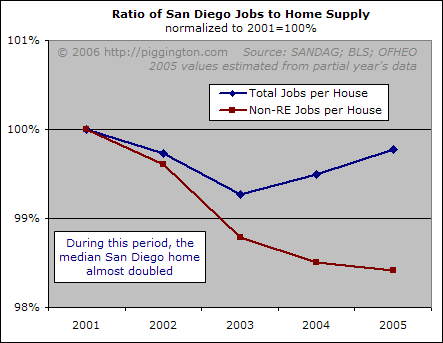Regarding my post on the Myth of the Housing Shortage, one commenter suggested that I look at jobs vs. housing supply instead of of population vs. housing supply. I have done so below, with surprising results:

Using job growth instead of total population growth lends even less support to the idea that home prices have risen based on fundamentals. During the most dramatic part of the housing boom—a period in which home prices rose by 88%—the San Diego home supply grew faster than the number of jobs. And as the chart shows, the disparity between growth in the housing supply and growth in non-real estate or construction jobs was even more dramatic.
Feel free to show this chart to anyone who still believes that there is a housing shortage in San Diego.

The really good thing about
The really good thing about fundamentals is that they are so fundamental. Lots of people want to wish them away but that is so not going to happen
I concur. Data (especially
I concur. Data (especially stats.) can be twisted and bent like baloon animals but the fundamentals are fairly rigid. What I appreciate most about Rich’s analyses is that his conclusions are based on analysis of the facts rather than looking for facts to prove or disprove a point.
If I read this graph right, then the number of jobs in 2005 is almost at 2001 levels. The increase in RE jobs has offset the decrease in jobs of other sectors. I am actually plesantly surprised that the increase in RE jobs is less than 2 points from 2001 to 2005. I would have thought it was more.
“End of line.”
That’s the most surprising
That’s the most surprising yet unsurprising graph I’ve seen vis-a-vis the housing bubble. Could you do the same thing for me for Marin County? I don’t know where to get that sort of data…I’m lame.
Rich:
A very useful
Rich:
A very useful graph.
Sure would be interesting to add median
Household incomes to each ‘Total Jobs
per House’ data point. (5 data points).
If household income in SD has followed similar
trends to what we have seen in the OC, I would
suspect household incomes have barely moved
during 5 year period.
Rich:
Here is what I
Rich:
Here is what I found
http://www.census.gov/prod/2005pubs/p60-229.pdf
Report page 3, PDF viewer page 10, figure 1
Real Median Household income: 1967 to 2004
Issues:
Data is for entire US, not specifically SD.
Granularity is coarse, hard to extract exact values.
Having said that, data still might be useful, in
that it is published by a reliable source.
Perhaps it would not be unreasonable to multiply
each yearly value by a factor (guestimate = 1.7)
to arrive at SD median?
Even given that the data is coarse, I believe that
it still refutes the Realtor community main premise
that the growth in jobs translates directly into
significantly higher household incomes to such
an extent that it could offset/justify current real
estate prices.